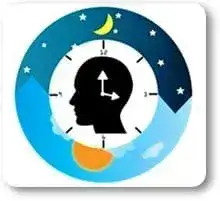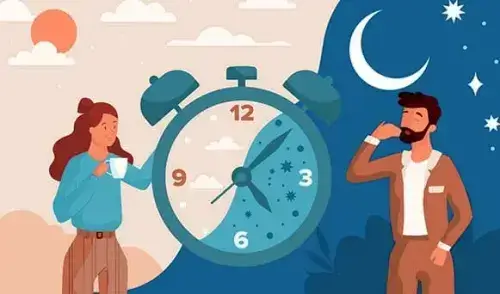Biological Rhythms. A long time ago, Japanese scientists announced the discovery of a gene responsible for the functioning of the human biological clock. This is the name of the system built into our bodies that determines the rhythm of our internal organs and the body as a whole.
Biological rhythms, the whole of human life is subject to it.
This is not a mystical concept from astrology or metaphysics, but a scientifically proven fact. In the article I will tell you what rhythms affect human health and well-being.
Biological rhythms are rhythms associated with metabolic activity and hormone production in the human body. Scientists distinguish at least five varieties of such rhythms.
1. High-frequency rhythms.
They can be from fractions of a second to 30 minutes. For example, every 23 seconds the same amount of blood passes through the pulmonary and systemic circulation. The brain, lungs, intestines and ureters work at a certain frequency.
2. Medium-frequency rhythms.
From 30 minutes to a day. It has been observed that human performance changes every 2 hours. At certain times of the day, many hormones are produced – in particular, cortisol, the synthesis of which reaches a peak at 5-6 in the morning.
3. Low-frequency rhythms.
They can be up to 7 days. For example, the level of red blood cells and white blood cells in a healthy person is updated every 5-7 days.
4. Monthly rhythms.
An example is the menstrual cycle in women, which lasts 21-35 days, and during this time the production of ovarian hormones changes.
5. Long rhythms, about a year.
It is known that in winter the concentration of glucose and energy sources ATP in human blood decreases. In summer, their concentration, on the contrary, increases.
Biological rhythms, circadian.
Circadian rhythms are one of the types of biological rhythms associated with the time of day.
The mechanism that controls our body’s rhythms is located in the subcortical structures of the brain. Organs and tissues have their own clocks, but their synchronization is carried out by the main rhythm control center.
There are special groups of neurons in the human retina – ganglia. Some cells of these ganglia contain melanopsin, a light-sensitive pigment that reacts to radiation in the blue part of the spectrum (from 450 to 485 nm).
Through vision, we receive information about daylight and night darkness. It enters the rhythm control center through the retina with melanopsin-containing cells.
From there, the signal is sent to the upper cervical ganglion, where the neurotransmitter norepinephrine is produced under the influence of a nerve impulse.
Norepinephrine molecules enter the pineal gland, an endocrine gland located in the brain.
Finally, it is in the pineal gland that the production processes of melatonin – a hormone that activates or inhibits various biochemical processes throughout the body – are initiated.
Biological rhythms, an important point.
Melatonin is practically not produced during the day, it is a night hormone, which even got the name “chemical marker of the night”.
Scientists managed to find out that they are transmitted at the gene level and depend on hereditary predisposition. Therefore, a child’s biorhythms always coincide with the rhythms of one of the parents.
The balance of circadian rhythms and light.
Having reached the sensitive receptors of the retina, in the retina, it passes to the brain – and “wakes” it up. In the dark, a person falls asleep faster, in the light – he feels cheerful.
Interestingly, circadian rhythms continue to function even in artificial lighting – this is a “built-in” mechanism that signals the body when it is time to go to bed and when it is time to be active.
Scientists have observed that in the human body, all organs and systems have their own biological timers, and they work according to a certain schedule.
For example, at five in the morning the temperature rises, the level of melatonin decreases, but cortisol increases, and the person wakes up.
Around seven o’clock his stomach starts to work – it’s time for breakfast. By ten o’clock all internal organs are ready for work, the nervous system is in a state of excitement.
By noon, efficiency decreases, and the production of hydrochloric acid in the stomach increases again – it’s time for lunch.
In the evening.
After seven, the level of cortisol decreases, performance decreases, the body prepares for a night’s rest.
After midnight, all processes slow down, the temperature and pressure decrease, the production of hormones becomes minimal. Individual features of the circadian rhythm are called chronotype. Scientists distinguish three types.
Larks – wake up early, full of energy immediately after waking up. But quite quickly – in the second half of the day – they get tired, and at 20-21 o’clock they are already falling, so they go to bed early.
Pigeons – wake up later than larks, but also go to bed at 22-23. The peak of their activity and maximum efficiency is 10-12 and 16-18.
Owls – get up late, fall asleep after midnight. The peak of their activity and performance falls on the second half of the day, in the evening and at night. In the morning they are lethargic and sleepy, until about noon.
The activity of people of different chronotypes is associated with changes in hormone levels. For example, in larks, cortisol levels decrease in the evening, and melatonin levels increase. Owls ir on the contrary.
Interestingly, circadian rhythms even affect the formation of genes. Swiss scientists are talking about this. They discovered that the maximum production of genes in the human body occurs at 7:00 and 19:00.
In addition, genes for active work, metabolism and stress response are expressed in the morning. However, in the evening, genes help to relax and fall asleep, and are also responsible for immunity.
Biological rhythms and oncological diseases.
The first reports of the connection of cancer with circadian rhythm disorders appeared more than 20 years ago. Norwegian scientists noticed that Norwegian radio dispatchers and employees had an increased incidence of breast cancer.
Then, thanks to studies by Japanese scientists, it turned out that prostate cancer is more common in men who work shift work (night or day).
These cancers also pose a greater threat to flight attendants and pilots who work for international airlines and regularly cross several time zones.
In the United States, an increased risk of breast, endometrial, and colon cancer has also been found in nurses who work shifts.
Scientists have discovered the mysterious link between cancer and shift work. Both breast cancer and prostate cancer are hormone-dependent tumors. Namely, the production of estrogen and progesterone, human sex hormones, depends on melatonin, which we talked about earlier.
During shift work, melatonin ceases to inhibit the production of sex hormones at certain hours of the day, which causes disruption of their receptors – and this is the first step on the path to cancer.
Biological rhythms, seasonal.
Seasonal rhythms are characteristic of all living nature. In spring, green foliage appears and grass begins to grow more intensively. In summer, for example, apple trees, when flowering ends, fruits begin to form.
In autumn and winter, it is time for a change in the annual cycle. Leaves fall, migratory birds flock south, squirrels gather nuts, and bears hibernate.
Humans do not have a pronounced seasonality, but natural rhythms also affect them. It has been observed that children gain maximum weight and height in spring and summer.
In winter, metabolism and cell growth slow down, glucose levels decrease, but the supply of adipose tissue increases. All these are natural processes aimed at human survival.
Although modern people do not need to stock up for the winter, you cannot argue with nature. Biological rhythms make themselves felt even in residents of large cities.
Interestingly, even the functioning of the immune system changes depending on the season. In autumn, metabolic processes in humans intensify, oxygen production increases. All this so that the body is saturated with vitamins and nutrients for the next winter.
Biological rhythms, age.
With age, a person’s well-being changes, it is not just a matter of accumulated diseases. Even a perfectly healthy man will be less active after 60 than a twenty-year-old guy.
This is because hormone levels and metabolic rate change over time. A young guy has more cortisol and adrenaline in his blood, fats and carbohydrates are broken down more easily, and the body quickly receives the necessary energy.
Long-term rhythms affect not only well-being.
It is observed that the effectiveness of training for athletes is not always the same. Male athletes achieve the best results once every three years, and women – once every two years.
Changes in the psyche take more time – about 7 years. Therefore, creative surges in a person usually occur at the age of 7, 14, 21, 28, and so on.
Biological rhythms, conclusion.
Usually our body is designed for a regular change of day and night. There are special mechanisms that trigger the corresponding biochemical processes at the right time.
The synchronization of all these processes occurs in the human brain. Any failure of synchronization “from the inside” or violation of “external” rhythms negatively affects the functioning of the body.
The nervous, endocrine systems, heart and blood vessels suffer the most. The risk of developing cancer associated with the production of hormones increases.
Therefore, let’s observe the systematicity of biological rhythms and try to adhere to them.
 The effect of sound frequencies, 528 Hz on humans.
The effect of sound frequencies, 528 Hz on humans.
Let’s consider the question of what effect 528 Hz sound has on our condition, and, of course, let’s listen to it. If anything, listen to 528 Hertz online.
The frequency of 528 Hz is associated with the so-called “Sound of Love”, because it resonates with the heart chakra, therefore it is very often used in sound therapy practice.
- It is believed to have the following effects:
- Reduced stress and general anxiety
- Easier to fall asleep and improve sleep quality
- Increased energy levels
- Relief from complaints and negative thoughts
- Healing damaged tissues and repairing DNA
Even official science is actively paying attention to the sound with a frequency of 528 Hz.
Good Day!



